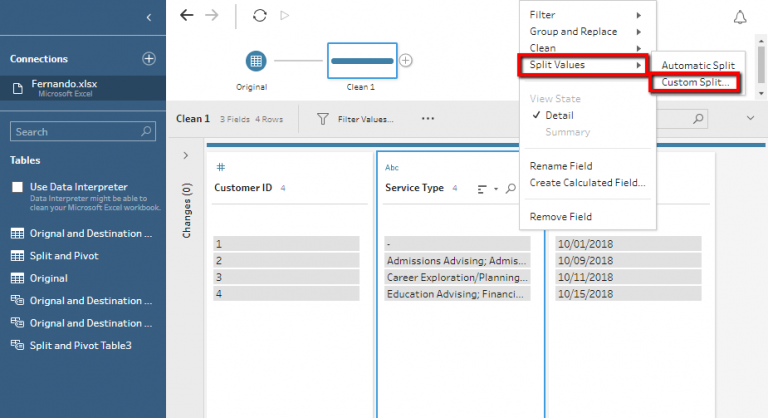

In particular, I consent to the transfer of my personal information to other countries, including the United States, for the purpose of hosting and processing the information as set forth in the Privacy Statement. Next we bring in the measure lookup (the mapping of measure names) and join that into the pivotted data. I bring the data in, Pivot it on the 3 measure names. Unfortunately, pivot tables don’t get along with Tableau (eg. How can I use Tableau Desktop to prepare my data For years, Excel has been used as the data conveyor/analysis tool by providing pivot tables and graphics. Step 3: Remove the unnecessary, original concatenated column. I've attached a quick example in Tableau Data Prep. 16 February, 2021 6 min reading time Charles Laporte I help you get insights from your data. Step 2: Split all values of the concatenated column into separate fields using a Clean step. I agree to the Privacy Statement and to the handling of my personal information. Step 1: Connect to data with an Input step. By submitting this form, you confirm that you agree to the storing and processing of your personal data by Salesforce as described in the Privacy Statement. By submitting this form, you acknowledge and agree that your personal data may be transferred to, stored, and processed on servers located outside of the People's Republic of China and that your personal data will be processed by Salesforce in accordance with the Privacy Statement.


To do so, select the field you want to pivot and drag it into the Pivot shelf. This will be very handy for open-end type data where people have to type something in without autocorrect. Tableau Prep makes it easy to pivot data in your data set. The Group and Replace option are used to group values manually or automatically by Pronunciation or Common Characters. Upon clicking, you will be shown a calculations screen, where you can add the filters. From the ‘Multiple Files’ tab, you can add filters to the rows by clicking the ‘filter values’ option. In the Clean menu you have options the following options, Make Uppercase, Make Lowercase, Remove Letters, Remove Numbers, Remove Punctuation and Trim Spaces. In the Input pane, you can select which rows you want in your flow, and how you want to sample your data from the ‘Data Sample’ tab. From a raw pivot table coming out of Excel, I was able to use Tableau Desktop and its set of Data prep tools to transform it into a tidy data-set that can be used in. Option 1: Pivot the Date Fields Pivot the date fields, so that there is only one field with date data, and a second field like 'Event' that describes whether the event is 'order placed' or 'order shipped' Note: for some data sources, pivoting can be done directly in Tableau Desktop. Finally, I convert the Date field as a Date. The new columns replace the original columns that you selected to create the pivot. New columns called 'Pivot field names' and 'Pivot field values' are created and added to the data source. Simply put as the process of converting data from crosstab format (which can be difficulty to work with) to columnar format. Click the drop-down arrow next to the column name, and then select Pivot. Take a look at the picture to see what I am talking about, easier to just see it.Īnother nice feature is the Clean and “Group and Replace” option. Tableau will then generate two new columns: Pivot Field Names and Pivot Field Values. Updated: Definition Pivoting data is the technique of data shaping that rotates data from a state of rows to a state of columns. Results appear immediately in both the Pivot Results pane and the data grid.
#TABLEAU PREP PIVOT ALIASES PLUS#
This new view is really nice, you can click on a value, and then it will trigger a highlight action which will highlight the values in the other fields that are made up by the value you clicked on. To add more columns to pivot on, click the plus icon in the Pivoted Fields pane in Tableau Prep Builder then repeat the previous step to select more fields to pivot. I used wildcard pivot so that the copy and paste works without additional tweaks to each pivot node.

Select multiple nodes and copy the selection to the clipboard and then select paste. You do all of this in the new profile pane view. Tableau Prep Builder has a better way to handle this potential repetition. This is the basic data cleaning step where you can rename fields, create calculated fields, filter data, split values and change data types. This step is the most robust step to me you can get a lot done in this step.


 0 kommentar(er)
0 kommentar(er)
